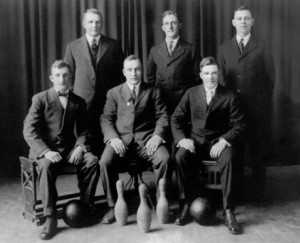I recently read an Adam Smith Esq. post that obliquely touches on one of my favorite complaints— the woeful lack of business development and other practical skills training in law firms. In “Checked Your Demographics Lately..?” Bruce MacEwen considers the ever growing ranks of BigLaw non-equity partners and the resulting “performance hazard” to institutions now facing unprecedented market changes. This, of course, is not news. Many of these lawyers are among those de-equitized over the past couple of years. Others slid past the up-or-out bar when client demand was higher. Some were even elevated to address diversity and other drivers, and left to their own devices once over the (first) partnership hurdle, with unsatisfying, largely cosmetic results. But Bruce, whom I believe is the most astute commentator on large law firm economics, is one of the first credible bloggers to argue so forcefully for simply letting the B team players go.
Bruce examines the arguments in favor of a non-equity class of partners and offers sensible responses—- those also given by the firms that have abandoned (or never adopted) two tier systems. Concluding that the top tier firms need to thin out the B team ranks, Bruce exhorts them to “manage for the long term”.
I worry that if we as an industry continue down the path of this quite marked demographic change, we will be putting more obstacles between ourselves and the high-performing organizations we all envision…….[F]or many firms outside the fortunate precincts of capital markets centers, or whose practices have no natural competitive barriers to entry, getting close to your clients—bordering on intimate—has never been more critical. Lawyers without powerful instincts for client relationship management may become a luxury you can no longer afford. [emphasis added]
What most concerns me about Bruce’s message is his apparent assumption that client-centric skills are instinctive, when it is clear that many of the so-called B-players could have been A-players had their firms offered them thorough networking, communication, client development, business generation, and other practical business skills training as associates, starting with the first year out of law school (where none of these skills are adequately addressed). (And by thorough, I mean intensive and consistent—a one hour bootcamp presentation on working a crowd doesn’t cut it.) In this post, Bruce recognizes the human capital component–but fails (and this truly surprised me) to hold the firms, or law schools, accountable for a failure to develop their people:
This is about, in a word, people. We know talent matters, we pay through the nose roof for headhunters to deliver lateral upon lateral, the statistical majority of whom will disappoint, we recruit the “best and the brightest” from law school (the statistical majority of whom, etc.), and yet when it’s time for our organizations to be agile and responsive to changing client expectations and market conditions, we find ourselves throttled. How can this be?
True: Lay-offs (of so many remarkable, highly skilled, profoundly committed lawyers) may well be necessary for partnerships who, having missed the memo on taking the long view, must now cut costs and keep their high producers from lateraling out. Bruce correctly advises his target audience — where both associate compensation and client fees are based mainly on billable hours, to “manage for the long term”. After all, the traditional law firm model, still all tangled up in divisive client credit and profit distribution standards, has (with AmLaw’s help) long generated myopic decision-making.
But non-equity partner lay-offs are a decidedly short-term fix. I wish that Bruce had also reminded his audience that any coherent long-term plan must include substantial investments of dollars and (otherwise billable) partner hours in the development of the firm’s human capital: its future partners… investments going well beyond best & brightest recruiting, CLE-driven legal training, credit scraps, and stock mentoring.
We lawyers are cautious, linear thinkers and notoriously loathe to take bold action. But then, that’s part of our great allure…. As Bruce MacEwan observes: Meaningful, lasting change is “not comfortable, and comfortable people won’t do it”.
But layoffs are not the only type of change that makes partners and senior administrative staff shift uneasily in their seats.
Only a tiny handful of law firm professional development programs offer the intensive training and coaching necessary to teach young lawyers to be competent client relationship managers and strategic networkers. By the same token, few firms offer their associates opportunities, via willing mentoring and responsible sponsorship, to access clients, client prospects, and – the holy grail — the new client and new matter credit without which absolutely no one makes the A team.
Firms must accept responsibility for the ways in which they have failed their associates, both young and seasoned, and their young partners, setting them up to be set adrift when, inevitably, client demand for high priced legal services began to fall off. As “Legal Rebel” Ed Reeser suggests, in so many words, in a terrific ABA Journal article I read just this morning, law firms need to get back into the “people business”.
Now that would be managing for the long term.
Note: For more from Bruce MacEwen I recommend subscribing to his blog, Adam Smith Esq., and reading this recent post, The Enabling Economy, where he explores another industry extreme: lateral equity hires (in its current wildly popular form, a stop-gap play I think dilutes firm culture with every newly acquired silo).
You may also like:
- Your Good Reputation: Common Courtesy
Business development is about relationships, first and foremost. What goes around comes around. Treat people right or pay the consequences in missed opportunities, broken relationships, burned bridges, and bad word of mouth….
- “Way Too Busy” to Build a Career? (Making Time for…
I can think of a million reasons why I don’t have the time to write this article. Pressing reasons. I’m “flat out”. Last week was “crazy” and it’s all I can do to catch up. I need some sleep. Did I already say that I’m “flat out”? I also have “a f…
- Best Practices for Summer Associates: In Three Simple Charts
A confession: I really really love charts. They help me think clearly. They entertain me. They keep things organized. So this year I offer all you summer associates my customarily blunt “best practices” advice in chart form. Three charts to be exact. Enjoy! And pass them on to the chart-less souls among your friends and family.
- What Do Blogging and Vegas Have in Common?? ….Building a…
It’s not as easy as it was for me–but much remains the same: Industry and skills specialization is still the fastest and smartest route to practice growth. Client contact, on the client’s turf, is still critical. Developing a reputation within your target industry or practice area still requires vastly more than a thorough understanding of the laws and regulations that affect it.


